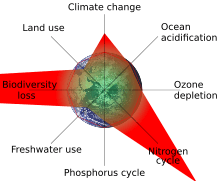Nanomaterials pollution
| Part of a series of articles on the |
| Impact of nanotechnology |
|---|
| Health |
| Environmental |
| Other topics |
|
Nanopollution is a generic name for waste generated by nanodevices or during the nanomaterials manufacturing process. Ecotoxicological impacts of nanoparticles and the potential for bioaccumulation in plants and microorganisms is a subject of current research, as nanoparticles are considered to present novel environmental impacts. Of the US$710 million spent in 2002 by the U.S. government on nanotechnology research, $500,000 was spent on environmental impact assessments.
Overview
Nanowaste is mainly the group of particles that are released into the environment, or the particles that are thrown away when still on their products. The thrown away nanoparticles are usually still functioning how they are supposed to (still have their individual properties), they are just not being properly used anymore. Most of the time, they are lost due to contact with different environments. Silver nanoparticles, for example, they are used a lot in clothes to control odor, those particles are lost when washing them.[1] The fact that they are still functioning and are so small is what makes nanowaste a concern. It can float in the air and might easily penetrate animal and plant cells causing unknown effects. Due to its small size, nanoparticles can have different properties than their own material when on a bigger size, and they are also functioning more efficiently because of its greater surface area. Most human-made nanoparticles do not appear in nature, so living organisms may not have appropriate means to deal with nanowaste.
The capacity for nanoparticles to function as a transport mechanism also raises concern about the transport of heavy metals and other environmental contaminants. Two areas of concern can be identified. First, in their free form nanoparticles can be released into the air or water during production, or production accidents, or as waste by-product of production, and ultimately accumulate in the soil, water, or plant life. Second, in fixed form, where they are part of a manufactured substance or product, they will ultimately have to be recycled or disposed of as waste.
Scrinis[2] raises concerns about nano-pollution, and argues that it is not currently possible to “precisely predict or control the ecological impacts of the release of these nano-products into the environment.” A May 2007 Report to the UK Department for Environment, Food and Rural Affairs noted concerns about the toxicological impacts of nanoparticles in relation to both hazard and exposure. The report recommended comprehensive toxicological testing and independent performance tests of fuel additives. Risks have been identified by Uskokovic in 2007.[3] Concerns have also been raised about Silver Nano technology used by Samsung in a range of appliances such as washing machines and air purifiers.
One already known consequences to metals exposure is shown by silver, if exposed to humans in a certain concentration, it can cause illnesses such as argyria and argyrosis.[4] Silver can also cause some environmental problems. Due to its antimicrobial properties (antibacterial), when encountered in the soil it can kill beneficial bacteria that are important to keep the soil healthy.[5] Environmental assessment is justified as nanoparticles present novel environmental impacts. Scrinis raises concerns[6] about nano-pollution, and argues that it is not currently possible to “precisely predict or control the ecological impacts of the release of these nano-products into the environment.”
Metals, in particular, have a really strong bonds. Their properties follow up to the nanoscale as well. Metals can stay and damage the environment for a long time, since they hardly degrade or get destroyed.[7] With the increase in use of nanotechnology, it is predicted that the nanowaste of metals will keep increasing, and until a solution is found for that problem, that waste will keep accumulating in the environment. On the other hand, some possible future applications of nanotechnology have the potential to benefit the environment. Nanofiltration, based on the use of membranes with extremely small pores smaller than 10 nm (perhaps composed of nanotubes) are suitable for a mechanical filtration for the removal of ions or the separation of different fluids. A couple of studies have found a solution to filtrate and extract those nanoparticles from water.[8] The process is still being studied but simulations have been giving a total of about 90% to 99% removal of nanowaste particles from the water at an upgraded waste water treatment plant. Once the particles are separated from the water, they go to the landfill with the rest of the solids.[9] Furthermore, magnetic nanoparticles offer an effective and reliable method to remove heavy metal contaminants from waste water. Using nanoscale particles increases the efficiency to absorb the contaminants and is comparatively inexpensive compared to traditional precipitation and filtration methods. One current method to recover nanoparticles is the Cloud Point Extraction. With this technique, gold nanoparticles and some other types of particles that are heat conductors are able to be extracted from aqueous solutions. The process consists of a heating section of the solution that contains the nanoparticles, and then centrifuged in order to separate the layers and then separate the nanoparticles.[10]
Life cycle responsibility
To properly assess the health hazards of engineered nanoparticles the whole life cycle of these particles needs to be evaluated, including their fabrication, storage and distribution, application and potential abuse, and disposal. The impact on humans or the environment may vary at different stages of the life cycle.
The Royal Society report[11] identified a risk of nanoparticles or nanotubes being released during disposal, destruction and recycling, and recommended that “manufacturers of products that fall under extended producer responsibility regimes such as end-of-life regulations publish procedures outlining how these materials will be managed to minimize possible human and environmental exposure” (p.xiii). Reflecting the challenges for ensuring responsible life cycle regulation, the Institute for Food and Agricultural Standards has proposed standards for nanotechnology research and development should be integrated across consumer, worker and environmental standards. They also propose that NGOs and other citizen groups play a meaningful role in the development of these standards.
See also
References
- ↑ Mueller, N.; Nowack, B. (2008). "Exposure Modeling Of Engineered Nanoparticles in the Environment". Environmental Science and Technology. 42: 4447–4453. doi:10.1021/es7029637.
- ↑ Gyorgy Scrinis (2007). "Nanotechnology and the Environment: The Nano-Atomic reconstruction of Nature". Chain Reaction. 97: 23–26. Archived from the original on July 19, 2008.
- ↑ Vuk Uskokovic (2007). "Nanotechnologies: What we do not know". Technology in Society. 29: 43–61. doi:10.1016/j.techsoc.2006.10.005.
- ↑ Drake, P.; Hazelwood, K. (2005). "Exposure-Related Health Effects of Silver and Silver Compounds: A Review". Oxford Journals. 49.
- ↑ Panyala, N.; Pena-Mendez, E.; Havel, J. (2008). "Silver or Silver Nanoparticles: a Hazardous Threat to the Environment and Human Health?" (PDF). Journal of Applied Biomedicine. 1214.
- ↑ Gyorgy Scrinis (2007). "Nanotechnology and the Environment: The Nano-Atomic reconstruction of Nature". Chain Reaction. 97: 23–26.
- ↑ Svintradze, D.; Pidaparti, R. (2010). "A Theoretical Model for Metal Corrosion Degradation". International Journal of Corrosion. 2010.
- ↑ Musee, N. (2010). "Nanowastes And The Environment: Potential New Waste Management Paradigm" (PDF). Environment International. 37.
- ↑ Kim, Y. (2014). "Nanowastes Treatment In Environmental Media". Environmental Health and Toxicology. 29: e2014015. doi:10.5620/eht.e2014015. PMC 4224314
 . PMID 25381912.
. PMID 25381912. - ↑ Soutter, W (2012). "Dealing With Nano-Waste: Can Nanoparticles Be Recycled?". AzoNano.
- ↑ Royal Society and Royal Academy of Engineering (2004). "Nanoscience and nanotechnologies: opportunities and uncertainties". Retrieved 2008-05-18.
Further reading
- National Research Council (2013). Research Progress on Environmental, Health, and Safety Aspects of Engineered Nanomaterials. Washington, DC: The National Academies Press. ISBN 978-0-309-29186-6. Retrieved 17 August 2014.
- National Research Council (2012). A Research Strategy for Environmental, Health, and Safety Aspects of Engineered Nanomaterials. Washington, DC: The National Academies Press. ISBN 978-0-309-25328-4. Retrieved 17 August 2014.
- National Research Council (2009). Review of Federal Strategy for Nanotechnology-Related Environmental, Health, and Safety Research. Washington, DC: The National Academies Press. ISBN 978-0-309-11699-2. Retrieved 17 August 2014.
- National Research Council (2005). Implications of Nanotechnology for Environmental Health Research. Washington, DC: The National Academies Press. ISBN 978-0-309-09577-8. Retrieved 17 August 2014.
- Colvin VL (Oct 2003). "The potential environmental impact of engineered nanomaterials". Nat. Biotechnol. 21 (10): 1166–70. doi:10.1038/nbt875. PMID 14520401.
External links
- University of California Center for Environmental Implications of Nanotechnology
- Duke University Center for the Environmental Implications of NanoTechnology

